Jinchang Ren
Vision Mamba in Remote Sensing: A Comprehensive Survey of Techniques, Applications and Outlook
May 01, 2025Abstract:Deep learning has profoundly transformed remote sensing, yet prevailing architectures like Convolutional Neural Networks (CNNs) and Vision Transformers (ViTs) remain constrained by critical trade-offs: CNNs suffer from limited receptive fields, while ViTs grapple with quadratic computational complexity, hindering their scalability for high-resolution remote sensing data. State Space Models (SSMs), particularly the recently proposed Mamba architecture, have emerged as a paradigm-shifting solution, combining linear computational scaling with global context modeling. This survey presents a comprehensive review of Mamba-based methodologies in remote sensing, systematically analyzing about 120 studies to construct a holistic taxonomy of innovations and applications. Our contributions are structured across five dimensions: (i) foundational principles of vision Mamba architectures, (ii) micro-architectural advancements such as adaptive scan strategies and hybrid SSM formulations, (iii) macro-architectural integrations, including CNN-Transformer-Mamba hybrids and frequency-domain adaptations, (iv) rigorous benchmarking against state-of-the-art methods in multiple application tasks, such as object detection, semantic segmentation, change detection, etc. and (v) critical analysis of unresolved challenges with actionable future directions. By bridging the gap between SSM theory and remote sensing practice, this survey establishes Mamba as a transformative framework for remote sensing analysis. To our knowledge, this paper is the first systematic review of Mamba architectures in remote sensing. Our work provides a structured foundation for advancing research in remote sensing systems through SSM-based methods. We curate an open-source repository (https://github.com/BaoBao0926/Awesome-Mamba-in-Remote-Sensing) to foster community-driven advancements.
FusDreamer: Label-efficient Remote Sensing World Model for Multimodal Data Classification
Mar 18, 2025Abstract:World models significantly enhance hierarchical understanding, improving data integration and learning efficiency. To explore the potential of the world model in the remote sensing (RS) field, this paper proposes a label-efficient remote sensing world model for multimodal data fusion (FusDreamer). The FusDreamer uses the world model as a unified representation container to abstract common and high-level knowledge, promoting interactions across different types of data, \emph{i.e.}, hyperspectral (HSI), light detection and ranging (LiDAR), and text data. Initially, a new latent diffusion fusion and multimodal generation paradigm (LaMG) is utilized for its exceptional information integration and detail retention capabilities. Subsequently, an open-world knowledge-guided consistency projection (OK-CP) module incorporates prompt representations for visually described objects and aligns language-visual features through contrastive learning. In this way, the domain gap can be bridged by fine-tuning the pre-trained world models with limited samples. Finally, an end-to-end multitask combinatorial optimization (MuCO) strategy can capture slight feature bias and constrain the diffusion process in a collaboratively learnable direction. Experiments conducted on four typical datasets indicate the effectiveness and advantages of the proposed FusDreamer. The corresponding code will be released at https://github.com/Cimy-wang/FusDreamer.
FACT: Feature Adaptive Continual-learning Tracker for Multiple Object Tracking
Sep 12, 2024



Abstract:Multiple object tracking (MOT) involves identifying multiple targets and assigning them corresponding IDs within a video sequence, where occlusions are often encountered. Recent methods address occlusions using appearance cues through online learning techniques to improve adaptivity or offline learning techniques to utilize temporal information from videos. However, most existing online learning-based MOT methods are unable to learn from all past tracking information to improve adaptivity on long-term occlusions while maintaining real-time tracking speed. On the other hand, temporal information-based offline learning methods maintain a long-term memory to store past tracking information, but this approach restricts them to use only local past information during tracking. To address these challenges, we propose a new MOT framework called the Feature Adaptive Continual-learning Tracker (FACT), which enables real-time tracking and feature learning for targets by utilizing all past tracking information. We demonstrate that the framework can be integrated with various state-of-the-art feature-based trackers, thereby improving their tracking ability. Specifically, we develop the feature adaptive continual-learning (FAC) module, a neural network that can be trained online to learn features adaptively using all past tracking information during tracking. Moreover, we also introduce a two-stage association module specifically designed for the proposed continual learning-based tracking. Extensive experiment results demonstrate that the proposed method achieves state-of-the-art online tracking performance on MOT17 and MOT20 benchmarks. The code will be released upon acceptance.
HDMba: Hyperspectral Remote Sensing Imagery Dehazing with State Space Model
Jun 09, 2024



Abstract:Haze contamination in hyperspectral remote sensing images (HSI) can lead to spatial visibility degradation and spectral distortion. Haze in HSI exhibits spatial irregularity and inhomogeneous spectral distribution, with few dehazing networks available. Current CNN and Transformer-based dehazing methods fail to balance global scene recovery, local detail retention, and computational efficiency. Inspired by the ability of Mamba to model long-range dependencies with linear complexity, we explore its potential for HSI dehazing and propose the first HSI Dehazing Mamba (HDMba) network. Specifically, we design a novel window selective scan module (WSSM) that captures local dependencies within windows and global correlations between windows by partitioning them. This approach improves the ability of conventional Mamba in local feature extraction. By modeling the local and global spectral-spatial information flow, we achieve a comprehensive analysis of hazy regions. The DehazeMamba layer (DML), constructed by WSSM, and residual DehazeMamba (RDM) blocks, composed of DMLs, are the core components of the HDMba framework. These components effectively characterize the complex distribution of haze in HSIs, aiding in scene reconstruction and dehazing. Experimental results on the Gaofen-5 HSI dataset demonstrate that HDMba outperforms other state-of-the-art methods in dehazing performance. The code will be available at https://github.com/RsAI-lab/HDMba.
Non-Destructive Peat Analysis using Hyperspectral Imaging and Machine Learning
May 03, 2024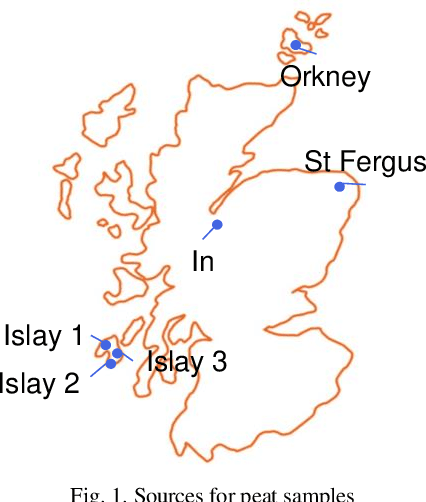

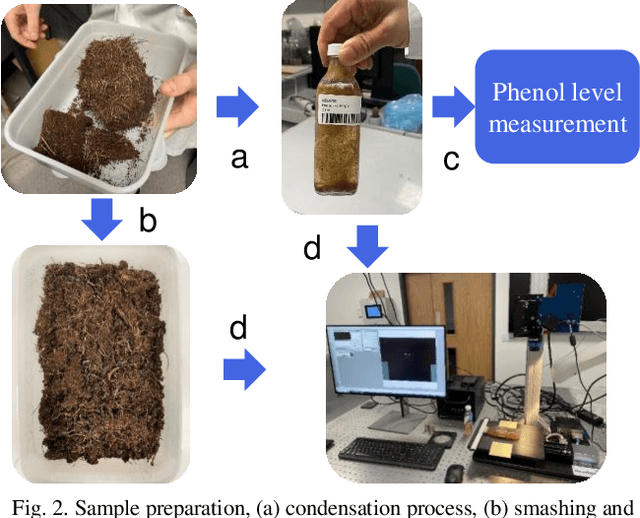
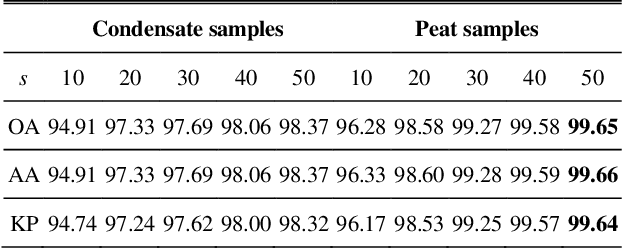
Abstract:Peat, a crucial component in whisky production, imparts distinctive and irreplaceable flavours to the final product. However, the extraction of peat disrupts ancient ecosystems and releases significant amounts of carbon, contributing to climate change. This paper aims to address this issue by conducting a feasibility study on enhancing peat use efficiency in whisky manufacturing through non-destructive analysis using hyperspectral imaging. Results show that shot-wave infrared (SWIR) data is more effective for analyzing peat samples and predicting total phenol levels, with accuracies up to 99.81%.
Siamese Residual Neural Network for Musical Shape Evaluation in Piano Performance Assessment
Jan 04, 2024



Abstract:Understanding and identifying musical shape plays an important role in music education and performance assessment. To simplify the otherwise time- and cost-intensive musical shape evaluation, in this paper we explore how artificial intelligence (AI) driven models can be applied. Considering musical shape evaluation as a classification problem, a light-weight Siamese residual neural network (S-ResNN) is proposed to automatically identify musical shapes. To assess the proposed approach in the context of piano musical shape evaluation, we have generated a new dataset, containing 4116 music pieces derived by 147 piano preparatory exercises and performed in 28 categories of musical shapes. The experimental results show that the S-ResNN significantly outperforms a number of benchmark methods in terms of the precision, recall and F1 score.
Segmentation Framework for Heat Loss Identification in Thermal Images: Empowering Scottish Retrofitting and Thermographic Survey Companies
Aug 07, 2023



Abstract:Retrofitting and thermographic survey (TS) companies in Scotland collaborate with social housing providers to tackle fuel poverty. They employ ground-level infrared (IR) camera-based-TSs (GIRTSs) for collecting thermal images to identi-fy the heat loss sources resulting from poor insulation. However, this identifica-tion process is labor-intensive and time-consuming, necessitating extensive data processing. To automate this, an AI-driven approach is necessary. Therefore, this study proposes a deep learning (DL)-based segmentation framework using the Mask Region Proposal Convolutional Neural Network (Mask RCNN) to validate its applicability to these thermal images. The objective of the framework is to au-tomatically identify, and crop heat loss sources caused by weak insulation, while also eliminating obstructive objects present in those images. By doing so, it min-imizes labor-intensive tasks and provides an automated, consistent, and reliable solution. To validate the proposed framework, approximately 2500 thermal imag-es were collected in collaboration with industrial TS partner. Then, 1800 repre-sentative images were carefully selected with the assistance of experts and anno-tated to highlight the target objects (TO) to form the final dataset. Subsequently, a transfer learning strategy was employed to train the dataset, progressively aug-menting the training data volume and fine-tuning the pre-trained baseline Mask RCNN. As a result, the final fine-tuned model achieved a mean average precision (mAP) score of 77.2% for segmenting the TO, demonstrating the significant po-tential of proposed framework in accurately quantifying energy loss in Scottish homes.
Nondestructive Quality Control in Powder Metallurgy using Hyperspectral Imaging
Jul 26, 2022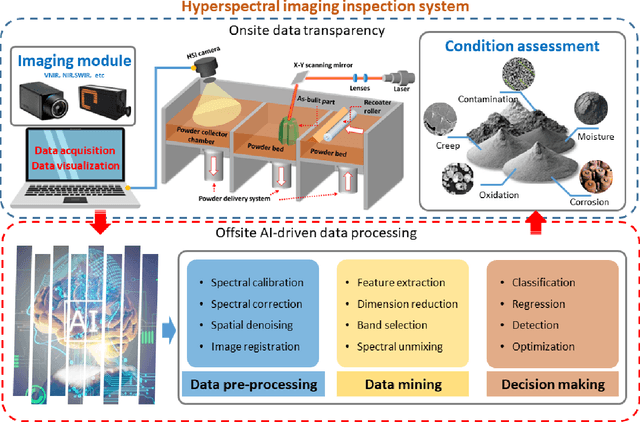
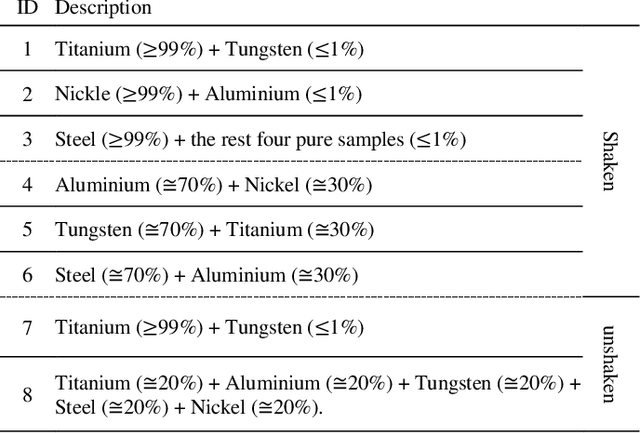
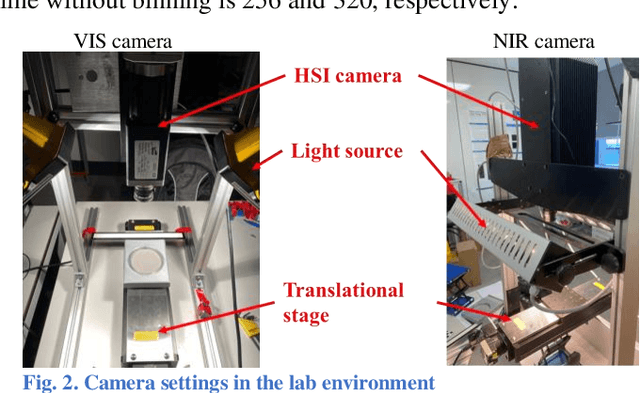

Abstract:Measuring the purity in the metal powder is critical for preserving the quality of additive manufacturing products. Contamination is one of the most headache problems which can be caused by multiple reasons and lead to the as-built components cracking and malfunctions. Existing methods for metallurgical condition assessment are mostly time-consuming and mainly focus on the physical integrity of structure rather than material composition. Through capturing spectral data from a wide frequency range along with the spatial information, hyperspectral imaging (HSI) can detect minor differences in terms of temperature, moisture and chemical composition. Therefore, HSI can provide a unique way to tackle this challenge. In this paper, with the use of a near-infrared HSI camera, applications of HSI for the non-destructive inspection of metal powders are introduced. Technical assumptions and solutions on three step-by-step case studies are presented in detail, including powder characterization, contamination detection, and band selection analysis. Experimental results have fully demonstrated the great potential of HSI and related AI techniques for NDT of powder metallurgy, especially the potential to satisfy the industrial manufacturing environment.
Nondestructive Testing of Composite Fibre Materials with Hyperspectral Imaging : Evaluative Studies in the EU H2020 FibreEUse Project
Nov 04, 2021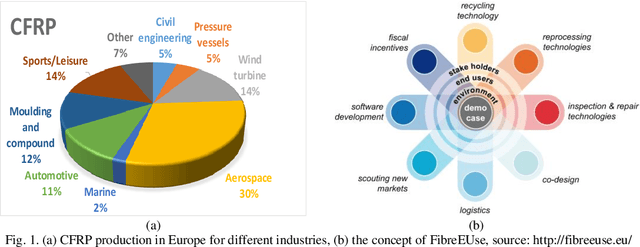
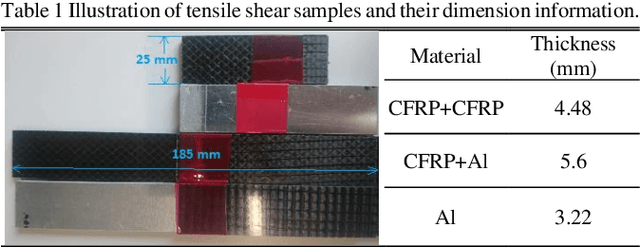
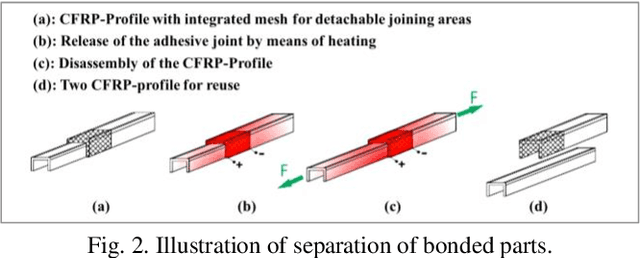
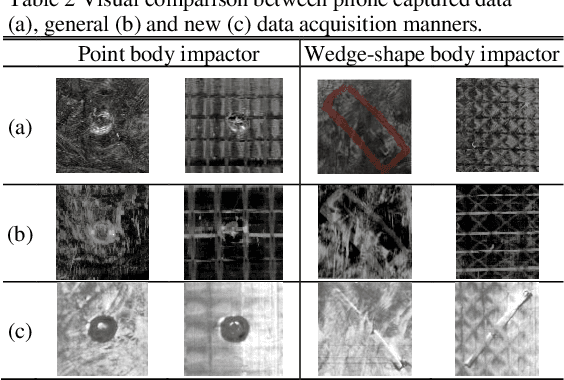
Abstract:Through capturing spectral data from a wide frequency range along with the spatial information, hyperspectral imaging (HSI) can detect minor differences in terms of temperature, moisture and chemical composition. Therefore, HSI has been successfully applied in various applications, including remote sensing for security and defense, precision agriculture for vegetation and crop monitoring, food/drink, and pharmaceuticals quality control. However, for condition monitoring and damage detection in carbon fibre reinforced polymer (CFRP), the use of HSI is a relatively untouched area, as existing non-destructive testing (NDT) techniques focus mainly on delivering information about physical integrity of structures but not on material composition. To this end, HSI can provide a unique way to tackle this challenge. In this paper, with the use of a near-infrared HSI camera, applications of HSI for the non-destructive inspection of CFRP products are introduced, taking the EU H2020 FibreEUse project as the background. Technical challenges and solutions on three case studies are presented in detail, including adhesive residues detection, surface damage detection and Cobot based automated inspection. Experimental results have fully demonstrated the great potential of HSI and related vision techniques for NDT of CFRP, especially the potential to satisfy the industrial manufacturing environment.
SR-GAN: Semantic Rectifying Generative Adversarial Network for Zero-shot Learning
Apr 15, 2019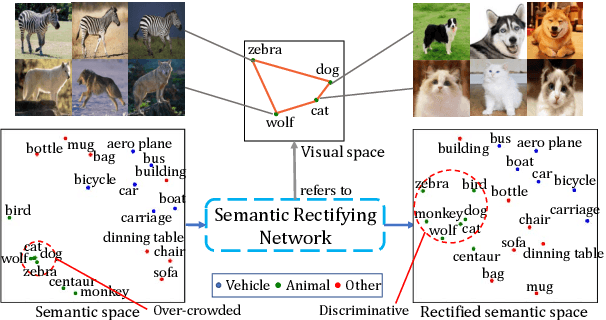
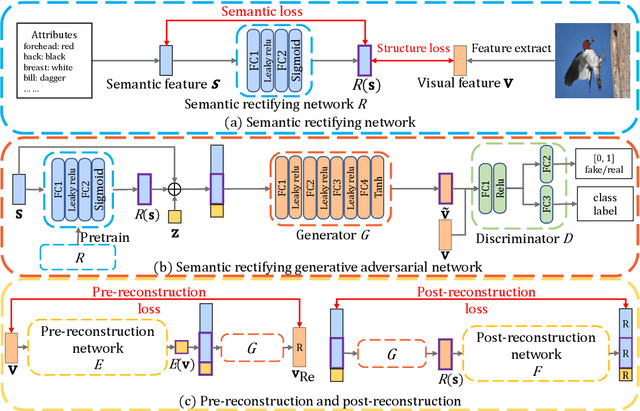
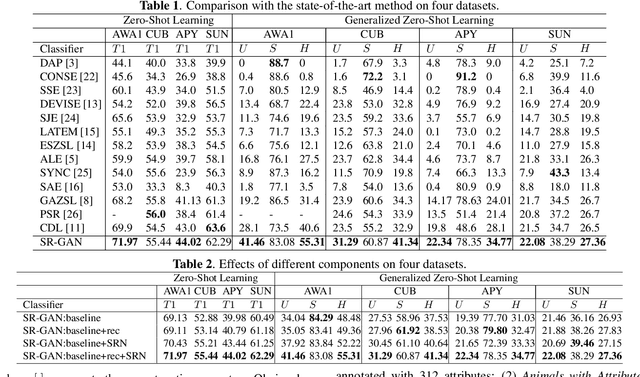
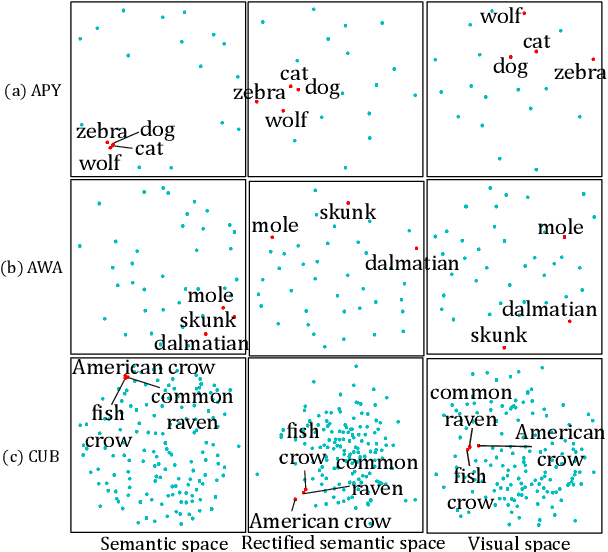
Abstract:The existing Zero-Shot learning (ZSL) methods may suffer from the vague class attributes that are highly overlapped for different classes. Unlike these methods that ignore the discrimination among classes, in this paper, we propose to classify unseen image by rectifying the semantic space guided by the visual space. First, we pre-train a Semantic Rectifying Network (SRN) to rectify semantic space with a semantic loss and a rectifying loss. Then, a Semantic Rectifying Generative Adversarial Network (SR-GAN) is built to generate plausible visual feature of unseen class from both semantic feature and rectified semantic feature. To guarantee the effectiveness of rectified semantic features and synthetic visual features, a pre-reconstruction and a post reconstruction networks are proposed, which keep the consistency between visual feature and semantic feature. Experimental results demonstrate that our approach significantly outperforms the state-of-the-arts on four benchmark datasets.
 Add to Chrome
Add to Chrome Add to Firefox
Add to Firefox Add to Edge
Add to Edge